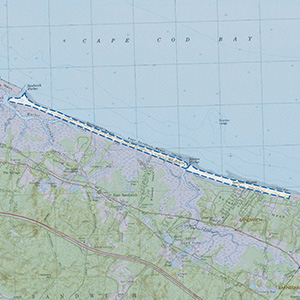Important Bird Area Sites in Massachusetts
Important Bird Area: Sandwich Beaches
Site Summary
Nominated By
Matt Bailey, Scott Hecker
Size
500 acres
Towns and Counties
Sandwich; Barnstable
Ownership
municipal, private
Major Habitats
salt marsh, coastal beach, marine/tidal, migratory stopover site
Land Use
nature & wildlife conservation/land trust, other recreation or tourism
IBA Criteria
- Category 1: Sites important for long-term research and/or monitoring projects that contribute substantially to ornithology, bird conservation, and/or education.
- Category 5: Seabirds: The site regularly supports 300 or more pelagic seabirds and/or terns or 3,000 or more gulls at one time. A pelagic site is the actual location being used by seabirds (e.g., Stellwagen Bank) and not the location from which an observer counts seabirds (e.g., Provincetown). Smaller concentrations of less common gulls such as Laughing or Bonaparte's gullswill be considered. Human-made food sources for gulls such as landfills and sewage outflows will not be considered. The designation "seabirds" includes shearwaters, storm-petrels, fulmars, gannets, jaegers, and alcids.
Site Description
This site consists of a chain of barrier beaches that run along Cape Cod Bay in the town of Sandwich. The substrate ranges from sand with stones or cobble to mostly cobble for most of the length, which serves to attract nesting Piping Plovers and Least Terns and to discourage recreational beachgoers. The beaches are backed up by either extensive salt marshes or private homes. It also directly abuts Sandy Neck, another area that has been nominated as an IBA. Productivity for the 20 or more pairs of nesting plovers is often well above the state average.
Current Conservation Status
Staff of the Mass Audubon Coastal Waterbird Program (CWP) monitor and fence plover nests. The CWP director works with regulatory officials to design beach nourishment projects that minimize damage to or even enhance the quality of nesting habitat.
Ornithological Significance
Notable numbers of Piping Plovers and Least Terns nest on this site, with the productivity of the plovers contributing solidly to the proliferation of the species. These shorebirds have been monitored at this site by Mass Audubon for the past 15 years. During migration, large numbers of shorebirds (more than 200 have been seen at one time) use this site as a stopover for rest and foraging. The salt marsh behind also provides refuge and forage for large numbers of wading and shorebirds.
Other Flora or Fauna of Significance
None known.
Data Sources
MassWildlife Tern Inventory and Piping Plover Reports, extensive records from the files of Mass Audubon's Coastal Waterbird Program.




